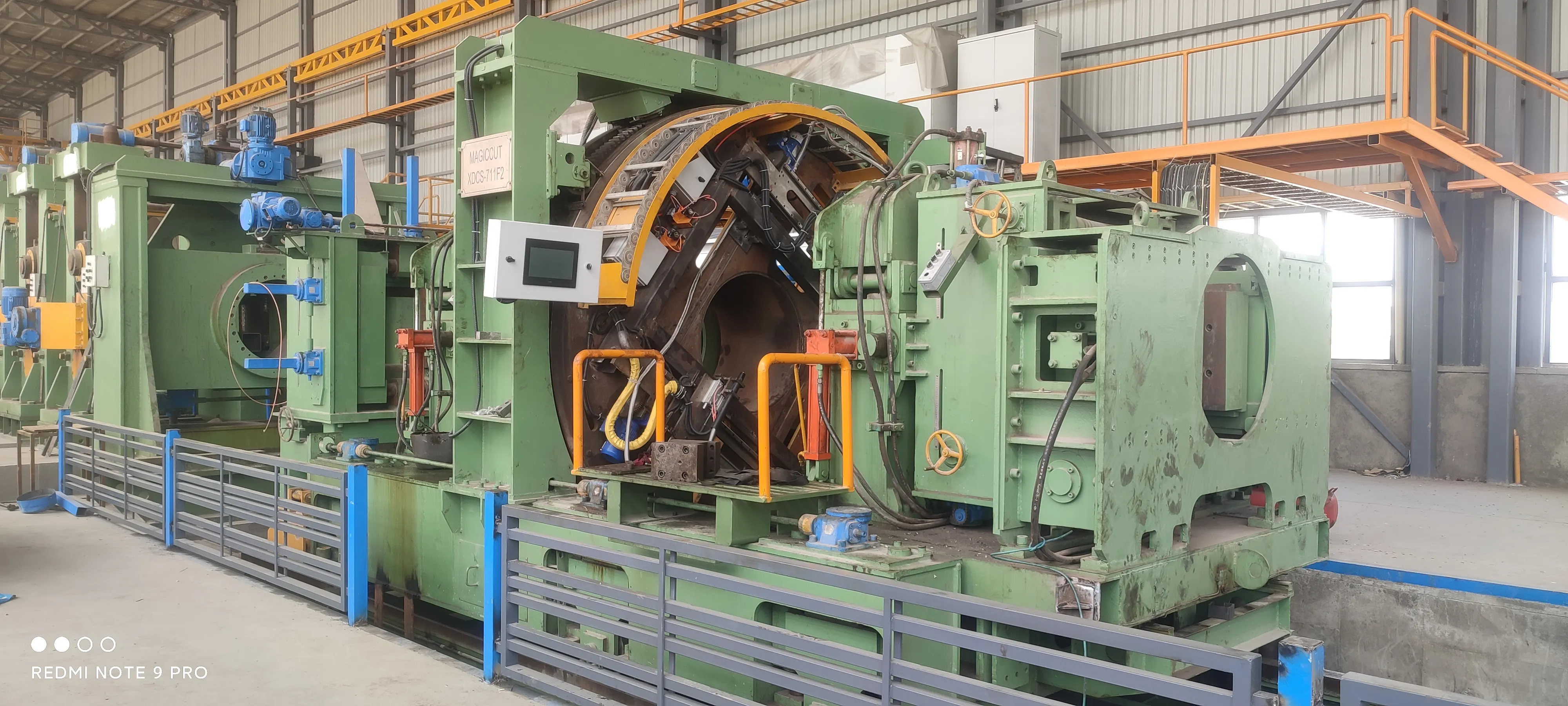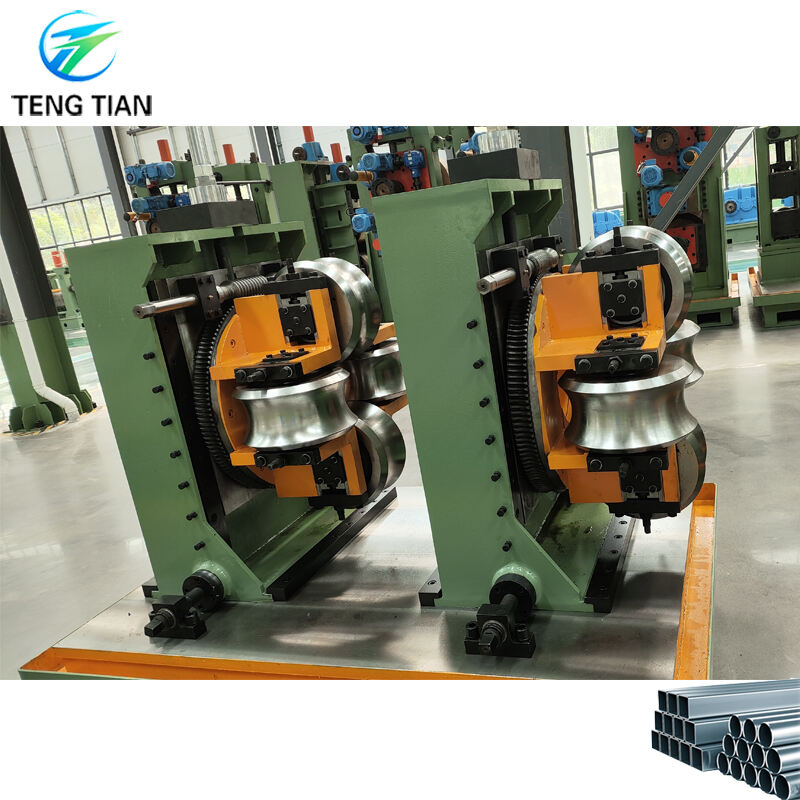Nagbabago ng Epektibidad ng Paggawa sa Pamamagitan ng Modernong Tube Production
Ang larangan ng pagmamanupaktura ay mabilis na nagbabago, at nasa unahan nito ay ang makabagong automated tube production line . Ang advanced na teknolohiya na ito ay lubos na nagbago kung paano hinaharapin ng mga industriya ang pagmamanupaktura ng tubo, na nag-aalok ng mga hindi pa nakikitaang antas ng kahusayan, tumpak na paggawa, at kapasidad ng output. Habang patuloy na tumaas ang pandaigdigang demand para sa mga produktong tubular sa mga sektor ng automotive, konstruksyon, at industriya, ang mga manufacturer ay bawat isa nang nakikilala ang makabuluhang benepisyo ng pag-upgrade ng kanilang tradisyunal na paraan ng produksyon patungo sa mga automated system.
Ang transisyon patungo sa automated na linya ng produksyon ng tubo ay kumakatawan sa higit pa sa simpleng pag-upgrade ng teknolohiya – ito ay isang estratehikong pamumuhunan sa hinaharap ng operasyon sa pagmamanupaktura. Dahil sa kakayahang magtrabaho nang 24/7 habang pinapanatili ang pare-parehong kalidad, ang mga system na ito ay nagtatakda ng mga bagong pamantayan sa kahusayan sa produksyon. Ang pagsasama ng automation ay naging lalong mahalaga habang kinakaharap ng mga industriya ang lumalaking presyon upang i-optimize ang mga gastos, bawasan ang basura, at matugunan ang mahigpit na mga kinakailangan sa kalidad.
Mga Pangunahing Benepisyo ng Automation sa Linya ng Produksyon
Pinagyaring Epektibong Operasyon at Produksyon
Ang isang automated na production line ng tube ay dramatikong nagpapataas ng bilis at pagkakapareho ng manufacturing. Hindi tulad ng manual na operasyon, ang automated system ay maaaring mapanatili ang peak performance level nang buong araw, na lubos na nagpapalaki ng daily output volume. Ang katiyakan ng automated equipment ay nagsisigurong ang bawat tube ay sumusunod sa eksaktong specification, pinamumutla ang paggamit ng materyales at binabawasan ang pangangailangan ng quality checks.
Ang modernong automated system ay maayos na nakakapagproseso ng maramihang laki at specification ng tube nang walang mahabang oras ng pagbabago. Ang kakayahang ito ay nagbibigay-daan sa mga manufacturer na mabilis na tumugon sa iba't ibang pangangailangan ng customer habang pinapanatili ang optimal na production efficiency. Ang pagtaas ng throughput capacity ay kadalasang nagreresulta sa mas mabilis na pagpuno ng order at pagpapahusay ng satisfaction ng customer.
Pagpapabuti ng Kontrol sa Kalidad at Pagkakaisa
Ang pangangalaga ng kalidad ay sumasailalim sa bagong dimensyon sa pamamagitan ng automated na linya ng produksyon ng tubo. Ang mga advanced na sensor at sistema ng pagmamanman ay patuloy na sinusubaybayan ang bawat aspeto ng proseso ng pagmamanupaktura, mula sa pagpapakain ng materyales hanggang sa inspeksyon ng huling produkto. Ang real-time na kontrol sa kalidad na ito ay nagsisiguro na ang anumang paglihis mula sa tinukoy na mga parameter ay agad na natutuklasan at tinatamaan, upang maiwasan ang produksyon ng mga depekto o hindi maayos na produkto.
Ang pag-elimina ng pagkakamali ng tao sa mga kritikal na hakbang sa produksyon ay nagreresulta sa napakalaking pagkakapareho ng kalidad ng produkto. Ang mga automated na sistema ay mahigpit na nagpapanatili ng kontrol sa mga salik tulad ng mga parameter ng pagmamasa, presyon sa pagbuo, at katiyakan ng pagputol, na nagreresulta sa mga tubo na tumutugon sa pinakamataas na pamantayan ng industriya sa bawat batch.
Mga Bentahe sa Pananalapi ng Paggamit ng Automation
Mga Estratehiya para sa Matagalang Pagbawas ng Gastos
Bagama't maaaring mukhang napakataas ng paunang pamumuhunan sa isang automated na linya ng produksyon ng tubo, ang mga matatag na benepisyong pampinansyal ay nakakumbinsi. Ang gastos sa paggawa ay lubos na nabawasan dahil ang mga automated na sistema ay nangangailangan ng kaunting interbensyon lamang ng tao para sa mga karaniwang operasyon. Bukod pa rito, ang pinabuting paggamit ng mga materyales at ang nabawasan na basura ay diretso na nakatutulong sa pagbaba ng gastos sa produksyon bawat yunit.
Ang gastos sa pagpapanatili ay karaniwang mas mababa rin sa matagalang paggamit, dahil ang mga automated na sistema ay idinisenyo na may pansin sa preventive maintenance. Ang kakayahang mahulaan at maiwasan ang mga problema sa kagamitan bago ito magdulot ng pagkabigo ay nakatutulong upang makatipid nang malaki sa mga gastos sa emergency repairs at pagkakasira ng produksyon.
Analisis ng Return on Investment
Ang mga kumpanya na nagpapatupad ng awtomatikong linya ng produksyon ng tubo ay karaniwang nakakakita ng kita sa kanilang pamumuhunan sa loob ng dalawa hanggang tatlong taon. Nakamit ang nakikinang ROI na ito sa pamamagitan ng maramihang salik, kabilang ang nadagdagan na kapasidad ng produksyon, binawasan ang gastos sa paggawa, at pinabuting kalidad ng produkto na nagreresulta sa mas kaunting pagbabalik ng customer. Ang kakayahang mag-operate nang patuloy na may pinakamaliit na pagkakagulo ay nagpapabilis pa sa pagbabalik ng pamumuhunan.
Ang mga benepisyong pinansyal ay umaabot nang lampas sa direktang pagtitipid sa gastos. Ang mga awtomatikong sistema ay nagbibigay-daan sa mga manufacturer na harapin ang mas malalaking order at mas kumplikadong mga proyekto, na nagbubukas ng mga bagong oportunidad sa merkado at mga daloy ng kita. Ang pagkakapare-pareho sa kalidad ng produkto ay nakatutulong din sa pagtatayo ng matagalang relasyon sa customer at sa pag-secure ng mas mataas na presyo para sa mga produkto.

Pagsasama ng Teknolohiya at Industry 4.0
Mga Kapasidad ng Smart Manufacturing
Ang mga modernong automated na linya ng produksyon ng tubo ay idinisenyo upang maisama nang maayos sa mga prinsipyo ng Industry 4.0. Ang mga sistemang ito ay may advanced na mga sensor at kakayahan sa pagkolekta ng datos na nagpapahintulot sa real-time na pagsubaybay at pagsusuri ng mga parameter ng produksyon. Ang kakayahang makalikom at magsuri ng datos ng produksyon ay nagreresulta sa patuloy na optimisasyon ng proseso at mapabuting paggawa ng desisyon.
Ang pagsasama ng mga tampok ng smart manufacturing ay nagpapahintulot sa predictive maintenance scheduling, remote monitoring capabilities, at automated quality control systems. Ang mga teknolohikal na pag-unlad na ito ay nagsisiguro na mananatili ang mga linya ng produksyon sa cutting edge ng manufacturing efficiency habang naghahanda para sa mga susunod na inobasyon sa industriya.
Mga Digital na Sistema ng Control at Pagsubaybay
Ang digital na imprastraktura ng isang automated na linya ng produksyon ng tubo ay nagbibigay ng hindi pa nakikita na kontrol sa mga proseso ng pagmamanupaktura. Ang mga advanced na sistema ng kontrol ay nagbibigay-daan sa mga operator na i-tune nang tumpak ang mga parameter ng produksyon, habang ang mga komprehensibong sistema ng pagmamanman ay sinusubaybayan ang lahat mula sa daloy ng materyales hanggang sa konsumo ng kuryente. Ang ganitong antas ng kontrol ay nagreresulta sa na-optimize na mga proseso ng produksyon at binawasan ang mga gastos sa operasyon.
Ang digital na integrasyon ay nagpapadali rin ng mas madaling paglutas ng problema at mga pamamaraan sa pagpapanatili. Ang mga kakayahan sa remote na diagnosis ay nagbibigay-daan sa teknikal na suporta na mabilis na tugunan ang mga isyu, habang ang detalyadong mga log ng produksyon ay tumutulong sa pagkilala at paglutas ng paulit-ulit na mga problema. Ang resulta ay minumunimong downtime at naibubuti ang kabuuang kahusayan ng kagamitan.
Mga Benepisyo para sa Kalikasan at Kapatiran
Optimisasyon ng mga Recursos at Pagbawas ng Basura
Ang mga automated na production line ng tubo ay nag-aambag nang malaki sa pangangalaga sa kalikasan sa pamamagitan ng mas mahusay na paggamit ng mga yaman. Dahil sa tumpak na kontrol sa pagpapakain at proseso ng mga materyales, nababawasan ang basura na nalilikha, samantalang ang mga modernong sistema ng pag-recycle ay maaaring mahusay na magamot ang anumang labis na materyales. Ang ganitong pag-optimize sa paggamit ng mga yaman ay hindi lamang nakakabawas sa epekto nito sa kalikasan kundi nakakatulong din sa pagbawas ng gastos.
Ang konsumo ng kuryente ay isa pang aspeto kung saan mahusay ang mga automated system. Ang mga modernong production line ay may mga bahagi na nakakatipid ng enerhiya at mga smart power management system na nag-o-optimize ng paggamit ng kuryente ayon sa pangangailangan sa produksyon. Dahil dito, mas maliit ang carbon footprint nito kumpara sa tradisyonal na paraan ng pagmamanupaktura.
Pagsunod sa Mga Pamantayan sa Pangkapaligiran
Ang pagpapatupad ng mga automated na linya ng produksyon ng tubo ay tumutulong sa mga manufacturer na matugunan ang palaging tumitinding mga environmental regulations. Ang mga sistemang ito ay kadalasang may mga built-in na feature para sa pagmamanman at kontrol ng emissions, upang matiyak ang compliance sa mga environmental standard habang pinapanatili ang kahusayan ng produksyon. Ang kakayahang maipakita ang environmental responsibility ay naging mahalagang ari-arian sa kasalukuyang merkado na may kamalayan sa kalikasan.
Dagdag pa rito, ang nabawasan na basura ng materyales at pinahusay na kahusayan sa enerhiya ay nakakatulong sa mas mabuting environmental performance metrics, na maaaring mahalaga para mapanatili ang mga sertipikasyon at matugunan ang mga kinakailangan sa sustainability ng mga customer.
Mga madalas itanong
Ano ang karaniwang timeline ng pagpapatupad para sa isang automated na linya ng produksyon ng tubo?
Ang pagpapatupad ng isang automated na linya ng produksyon ng tube ay karaniwang tumatagal ng 3 hanggang 6 na buwan, depende sa kumplikado ng sistema at tiyak na mga kinakailangan. Kasama sa timeline na ito ang mga yugto ng pag-install, pagsubok, at pagsasanay sa mga tauhan. Ang propesyonal na pagpaplano at pamamahala ng proyekto ay makatutulong upang matiyak ang maayos na transisyon na may pinakamaliit na pagbabago sa umiiral na operasyon.
Paano nakakaapekto ang automation sa umiiral na mga kinakailangan sa manggagawa?
Bagama't binabawasan ng automation ang pangangailangan ng pawisan sa direktang mga gawain sa produksyon, ito ay lumilikha ng mga bagong oportunidad para sa mga kasanayang posisyon sa operasyon ng sistema, pangangalaga, at kontrol sa kalidad. Maraming mga kompanya ang pumipili na muling magbigay-kaalaman sa mga kasalukuyang empleyado upang gampanan ang mga bagong tungkulin, na nagreresulta sa pagpapataas ng kasanayan ng manggagawa imbes na pagbawas nito.
Ano ang mga kinakailangan sa pangangalaga na dapat asahan sa isang automated na sistema?
Ang mga automated na production line ng tubo ay nangangailangan ng regular na preventive maintenance, na karaniwang iskedyul sa mga panahon ng planned downtime. Ang dalas at lawak ng maintenance ay nakadepende sa dami ng produksyon at kumplikado ng sistema. Karamihan sa mga modernong sistema ay may kasamang predictive maintenance features na makatutulong upang i-optimize ang iskedyul ng maintenance at mabawasan ang hindi inaasahang downtime.
Talaan ng mga Nilalaman
- Nagbabago ng Epektibidad ng Paggawa sa Pamamagitan ng Modernong Tube Production
- Mga Pangunahing Benepisyo ng Automation sa Linya ng Produksyon
- Mga Bentahe sa Pananalapi ng Paggamit ng Automation
- Pagsasama ng Teknolohiya at Industry 4.0
- Mga Benepisyo para sa Kalikasan at Kapatiran
- Mga madalas itanong

